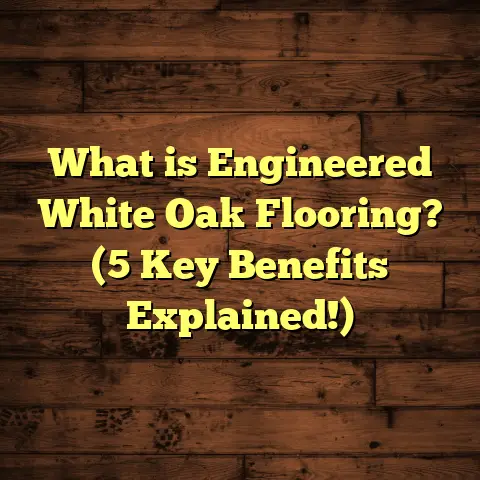What is Laminate Wood Flooring? (5 Benefits You Must Know!)
Laminate wood flooring has been quietly taking over the flooring market in recent years. I’ve noticed it popping up in more and more homes during my work as a flooring contractor. There’s a clear shift in homeowners’ preferences toward materials that blend beauty, durability, and cost-efficiency. If you’re someone who’s ever wondered about laminate floors—what they are, how they work, and why they’re suddenly everywhere—I’m here to walk you through everything I know.
What Exactly Is Laminate Wood Flooring?
Alright, so let’s start at the beginning: what is laminate wood flooring? It’s one of those terms that gets tossed around quite a bit, but not everyone really understands what it means beneath the surface.
Laminate flooring is a synthetic product designed to look like natural hardwood or sometimes stone. Unlike real wood planks, laminate isn’t made from solid wood but instead consists of several layers pressed together to form durable planks. The top layer is a photographic image of wood grain or stone texture, covered with a transparent, protective wear layer. Underneath that is a core layer made from high-density fiberboard or HDF, which gives the floor its strength and stability. The bottom layer serves as a moisture barrier and adds balance.
This layered system is what makes laminate unique. It’s not actual wood but gives you the look of wood without many of the downsides, like susceptibility to scratches or water damage. From my experience, it’s like getting the best parts of hardwood floors without paying the premium price or worrying about delicate maintenance.
How Laminate Compares to Other Flooring Types
People often ask me how laminate compares to hardwood or engineered wood. Hardwood is just that—solid wood planks milled from trees. It ages beautifully but requires regular upkeep and can be pricey. Engineered wood uses real wood veneers over plywood cores, offering some moisture resistance but still needing care.
Laminate’s printed surface allows for almost any design—oak, maple, walnut, or exotic woods—at a fraction of the cost. Plus, its wear layer protects it from scratches and stains better than many hardwoods. While you won’t be able to sand and refinish laminate like real wood, advances in technology mean you can get 15-25 years of use out of it without major issues.
1. Affordability That Doesn’t Skimp on Style
When I first started recommending laminate flooring, many clients were skeptical. They wanted the look of hardwood but were worried laminate would look cheap or plastic-y. Over time, I’ve watched the quality improve dramatically.
Laminate now offers incredibly realistic visuals thanks to high-definition printing techniques. Some manufacturers even add texture embossing that mimics the grain patterns and knots of real wood.
The best part? The price.
Laminate flooring typically costs between $1.50 and $4 per square foot for materials alone. Hardwood floors usually start around $5 per square foot and can go up well beyond $10 for premium species. For homeowners on a budget who still want a stylish floor, this price difference is significant.
I once worked on a complete home renovation where the clients loved the idea of hardwood but had a strict budget ceiling. After showing them laminate options with stunning oak and walnut looks, they were thrilled to get the same aesthetic for less than half the price.
Real Data on Cost Savings
According to industry statistics:
- Roughly 38% of homeowners choose laminate flooring primarily because of affordability.
- The average total cost (materials + installation) for laminate is about $2.50-$6 per square foot.
- Hardwood floors average $7-$15 per square foot installed.
That means for a typical 1,000-square-foot space, laminate can save you anywhere from $4,000 to $10,000 compared to hardwood.
2. Easy Installation Saves Time and Money
Another huge reason laminate is popular is how simple it is to install. Unlike hardwood floors that need nails or glue and precise measuring, laminate usually uses a click-lock system where planks snap together over an underlayment.
I’ve installed hardwood floors that took me days because of sanding, staining, and nailing processes. Laminate installations can often be done over a weekend by skilled pros—and sometimes even by confident DIYers.
My Personal Experience Installing Laminate
One memorable project was for a friend who wanted new floors but had zero experience with home improvement. I showed her how to lay laminate using the tongue-and-groove locking design. We finished her entire living room in just a day.
Because there’s no need for glue or nails, cleanup afterward is minimal too. Just sweep up any debris and you’re done.
Installation Cost and Time Comparison
The National Wood Flooring Association reports:
- Hardwood installation averages 3–5 days for 500-700 sq ft.
- Laminate installation often takes half the time.
- Labor costs for hardwood can run $3-$8 per sq ft; laminate labor is usually $1-$3.
Faster installs mean lower labor charges, which can save hundreds or thousands depending on your project size.
3. Durability That Handles Everyday Life
Homes are busy places—especially if you have kids or pets running around—and floors take a beating. With hardwood floors, scratches and dents can quickly show up if you’re not careful. Laminate flooring is built to resist these everyday challenges better.
The wear layer on laminate protects against scratches from shoes, furniture shifts, pet claws, and even minor spills. This makes it ideal for high-traffic areas like kitchens, hallways, and family rooms.
I’ve seen families with young children who were thrilled their floors didn’t show damage after years of use. One client told me their laminate floor looked “brand new” even after their toddler learned to walk—and fell plenty.
Technical Durability Ratings
Laminate flooring wear layers are rated by an Abrasion Class (AC) system:
- AC1: Light residential use (bedrooms)
- AC2: Moderate residential use (living rooms)
- AC3: Heavy residential use (kitchens)
- AC4: General commercial use (offices)
- AC5: Heavy commercial use (stores)
Most laminate sold for homes falls in AC3 or AC4 categories, meaning they’re tough enough for most households—and then some.
4. Moisture Resistance That Works for Various Spaces
Water damage is a nightmare with real wood floors. Even small spills can seep in cracks causing warping or staining over time. Laminate has made great strides in handling moisture with water-resistant core boards and improved locking profiles that reduce gaps where water could enter.
I recall installing water-resistant laminate in a basement apartment where humidity was always an issue. After monitoring for months, there were zero signs of swelling or damage despite occasional dampness.
This feature opens up possibilities for rooms you might hesitate to put hardwood in—like kitchens, bathrooms, laundry rooms, and basements.
How Laminate Compares on Moisture Resistance
- Hardwood floors can swell or cup with moisture exposure.
- Engineered wood performs better but still vulnerable if water sits long enough.
- Laminate with moisture-resistant cores can handle occasional spills and humidity better.
Still, standing water should be cleaned quickly regardless of flooring type to protect longevity.
5. Easy Maintenance That Fits Busy Lifestyles
One thing I always highlight about laminate floors is how easy they are to maintain. If you’re someone who hates mopping or waxing floors regularly, this material will be a relief.
No need for sanding or refinishing every few years like hardwood requires. A regular sweep and occasional damp mop are usually enough to keep them looking great.
I helped an elderly client switch from carpet to laminate because she wanted something easier on her allergies and simpler to clean. She loved not having to worry about stains setting in or expensive upkeep costs.
Maintenance Tips That Keep Laminate Beautiful
- Sweep/vacuum regularly to remove dirt that could scratch.
- Use damp cloth/mop—not soaking wet—to clean.
- Avoid harsh chemicals; mild detergent works well.
- Place felt pads under furniture legs.
- Wipe spills immediately to prevent staining or warping.
The Environmental Side of Laminate Flooring
Now you might wonder about environmental impacts since laminate uses synthetic materials instead of solid wood.
Manufacturers have been improving sustainability by using recycled wood fibers in core layers and reducing VOC emissions in adhesives and finishes.
I often discuss this with eco-conscious clients who want stylish floors but care about green choices.
How Laminate Can Be Eco-Friendly
- Many brands source timber from responsibly managed forests.
- Composite core boards often contain recycled materials.
- Durable design means less frequent replacement compared to carpet.
- Some laminates are certified low-emission (CARB Phase 2 compliant).
If reducing environmental footprint matters to you, look for certifications and inquire about materials used when shopping for laminate.
Common Myths About Laminate Flooring—Busted!
Over the years, I’ve heard plenty of misconceptions about laminate flooring floating around:
Myth #1: Laminate looks fake and cheap
Truth: Modern printing technology makes it incredibly realistic; many people can’t tell it apart from real wood without close inspection.
Myth #2: You can’t install laminate yourself
Truth: Many homeowners successfully install it as DIY projects thanks to click-lock designs and straightforward instructions.
Myth #3: Laminate doesn’t last long
Truth: With proper care, laminate can last 15-25 years or more—comparable to some hardwoods when factoring refinishing costs.
Myth #4: You can’t refinish laminate
Truth: This is true—laminate cannot be sanded like hardwood. But its durable wear layer reduces need for refinishing.
Myth #5: Laminate damages easily from water
Truth: Water-resistant laminates handle spills much better than before; quick cleanup prevents damage.
Real-Life Case Studies from My Projects
I want to share some stories from my work because I believe real experiences help paint the clearest picture.
Case Study 1: Family Home Upgrade in Minnesota
A family with two kids wanted hardwood floors but worried about scratches and cost constraints. We chose an AC4-rated oak-look laminate with textured embossing that mimicked authentic grain patterns beautifully.
After three years of heavy foot traffic—including pets—the floor still looks pristine. The family reports easy cleanup after spills and zero worries about dents from toys or furniture moves.
Case Study 2: Basement Renovation in Seattle
The homeowner needed durable flooring resistant to moisture but wanted warmth instead of cold tiles. We installed water-resistant laminate planks over a moisture barrier underlayment.
Six months post-installation with rainy weather conditions showed no signs of warping or mold growth—a relief compared to their previous carpeted basement that trapped moisture and odors.
Case Study 3: Rental Property Makeover in Texas
Landlords needed an affordable flooring option that tenants wouldn’t damage easily between rentals. Laminate’s scratch resistance and quick installation made it ideal.
Turnover times shrank because cleanup was faster with no staining issues—boosting rental income efficiency significantly.
How to Choose the Right Laminate Flooring for Your Home
Picking laminate isn’t just about price—it’s about matching your lifestyle and space needs.
Consider These Factors:
- Abrasion Class Rating: Higher AC ratings mean tougher wear layers.
- Thickness: Most range from 6mm (budget) to 12mm+ (premium). Thicker feels more solid underfoot.
- Design: Choose colors and grains that fit your décor theme—light woods brighten rooms; dark woods add warmth.
- Water Resistance: Look for brands specifying water-resistant cores if installing in humid areas.
- Underlayment: Adds soundproofing and cushioning; some laminates include this pre-attached.
- Warranty: Longer warranties often indicate better quality materials and manufacturing processes.
Installation Tips From My Experience
If you’re thinking about installing laminate yourself or want to oversee pros effectively, here are some pointers:
- Let planks acclimate in your home for 48 hours before installation.
- Prepare subfloor by cleaning thoroughly and leveling any bumps.
- Use the right underlayment recommended by manufacturer.
- Leave expansion gaps around edges as instructed.
- Stagger plank seams for natural appearance.
- Use spacers along walls during installation.
- Clean surface regularly during install for dust-free adhesion between planks.
Cost Breakdown and Budget Planning
Planning financially helps avoid surprises mid-project:
| Item | Estimated Cost per Sq Ft | Notes |
|---|---|---|
| Laminate Material | $1.50 – $4 | Depends on brand & style |
| Underlayment | $0.25 – $0.75 | Often included |
| Labor | $1 – $3 | DIY saves labor |
| Accessories | $0.10 – $0.50 | Transition strips, moldings |
| Waste Factor | 5% – 10% extra | Cutoffs & mistakes |
For example:
A 700 sq ft room might cost:
- Materials: $1,400 – $2,800
- Labor: $700 – $2,100
- Accessories & Waste: ~$200
Total: Around $2,300 – $5,100
Using online tools like FloorTally can help generate precise estimates tailored for your location and preferences.
Design Trends Using Laminate Flooring
Laminate has evolved beyond basic oak patterns into rich textures and colors:
- Wide Planks: Mimic upscale hardwood styles with wider boards.
- Distressed & Hand-Scraped Looks: Add rustic character popular in farmhouse designs.
- Gray Tones: Cool grays fit modern minimalist interiors.
- Exotic Woods: Zebrawood or Brazilian cherry patterns provide bold statements.
- Mixed Width Patterns: Create unique flooring layouts for visual interest.
I love recommending creative layouts like herringbone or diagonal installs with laminate—it’s easier than hardwood but looks just as stylish.
Final Thoughts From My Flooring Journey
Over the years installing floors in dozens of homes—from cozy apartments to large family houses—I’ve come to appreciate how laminate flooring blends beauty with practicality like few other options do.
If you’re debating between hardwood’s prestige and affordability concerns versus tile’s cold feel or carpet’s maintenance hassles—laminate offers a compelling middle ground.
It’s a choice that suits many lifestyles: budget-conscious families, busy professionals wanting low upkeep, renters needing durable surfaces, or anyone craving the look of wood without the fuss.
Feel free to reach out if you want guidance on picking brands, styles, or tips on installation—I’m always happy to help friends make smart flooring decisions based on real-world experience!
If you have questions about specific products or need help planning your project budget-wise or style-wise—just ask!





